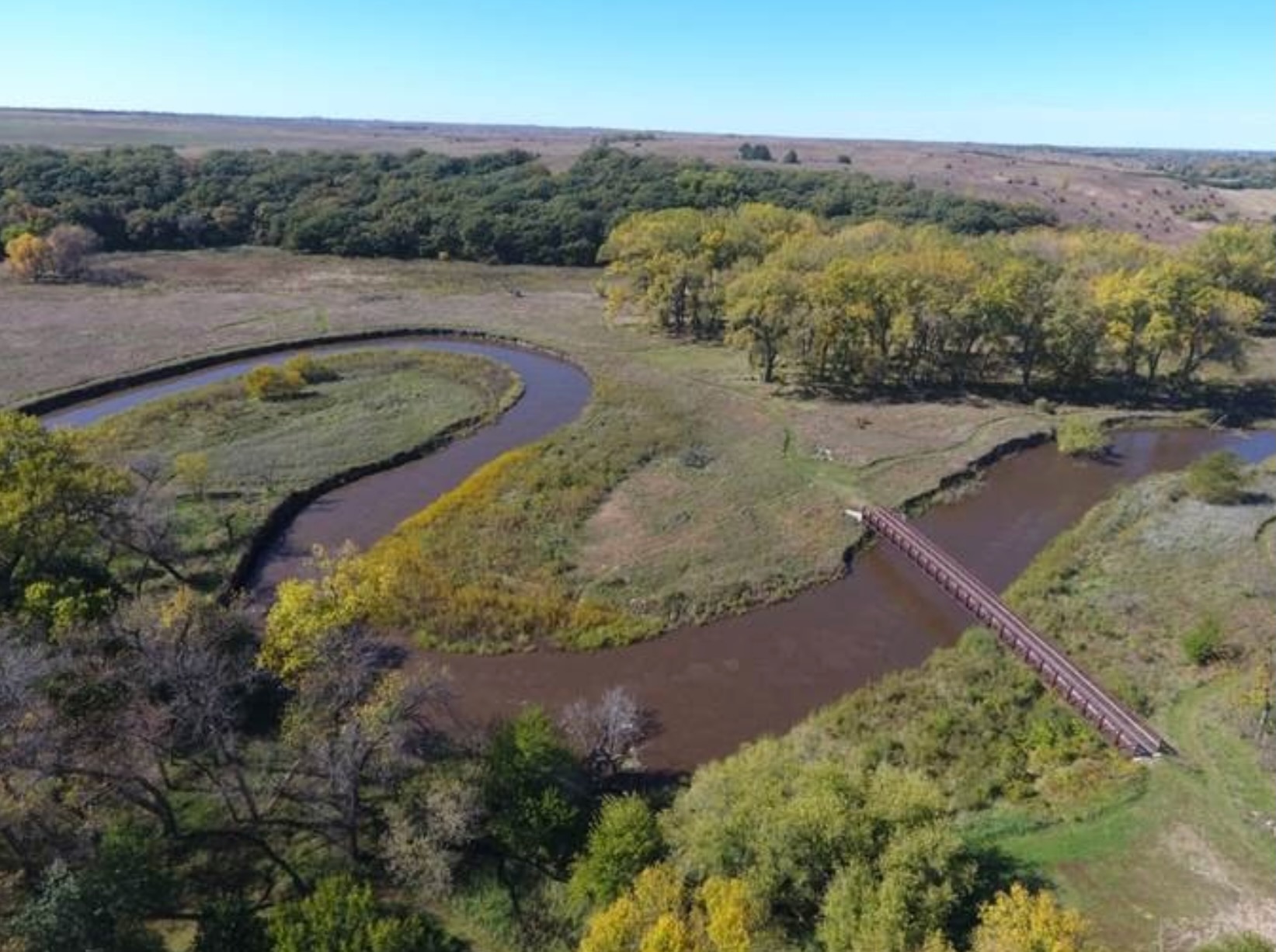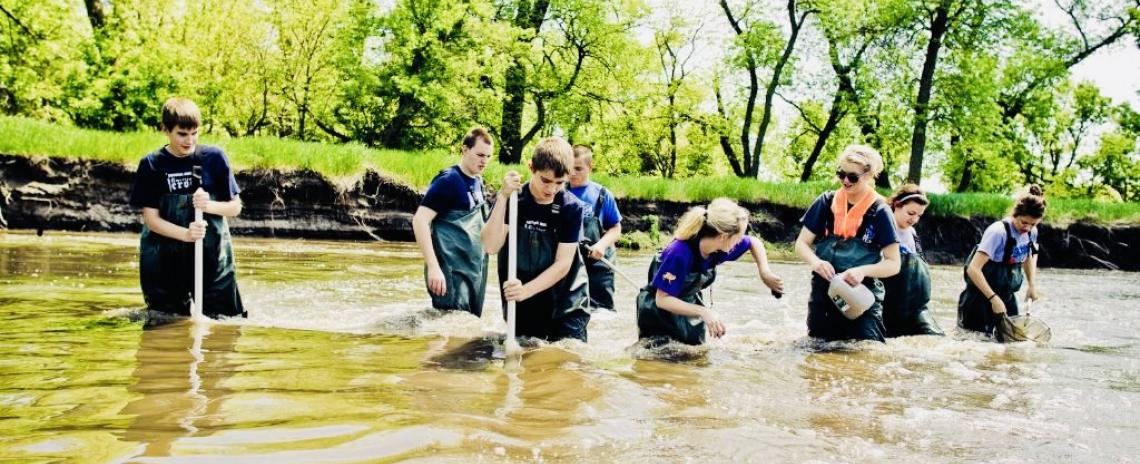Wading the Waters of Shell Creek: Newman Grove’s citizen science project dates back a quarter century
Wading the Waters of Shell Creek: Newman Grove’s citizen science project dates back a quarter century
By Tyler Dahlgren
Newman Grove science teacher Brett Miller and a group of his student scientists were about a mile south of town, wading the waters of Shell Creek until they reached a set of fish traps they’d set the day before.
It was a humid summer night in 2022, and though the day had been busy, the picturesque stream was calm now. Its waters, which have been studied by Newman Grove student conservationists each summer since 2002, ran smooth and the crickets and cicadas were filling the air with their usual songs.
Now a senior just months from graduation, Zander Jarecki remembers that night like it was yesterday. He remembers a couple unremarkable finds in the first couple of traps, and then the eye-opening discovery in the next. A Smallmouth Bass has never made a group of highschoolers happier.
“It was something I had never seen in the creek, and I’d been studying the creek since the seventh grade,” Jarecki said. “We went back and searched the record books, and they hadn’t found one in decades.”
They let the fish go and he was on his way, a living, breathing sign of life that reaffirmed a citizen science project that’s bloomed into a beloved tradition in Newman Grove for nearly a quarter century.
In the late 1990s, Shell Creek, a stream that runs through the heart of Newman Grove and drains into a watershed that covers approximately 304,873 acres, was in rough shape. A lack of conservation farming practices and channelization had, over time, resulted in excessive erosion, frequent flooding (in the 80s and 90s alone, three separate 100-year floods came through Newman Grove), poor water quality and a loss of aquatic life.
In 1999, a group of farmers and landowners took the first step towards mitigation and formed the Shell Creed Watershed Improvement Group (SCWIG). Included in their initial Watershed Management Plan (WMP) was an outreach program involving local high school students. Newman Grove not only embraced the idea, they viewed it as an opportunity to do something really cool.
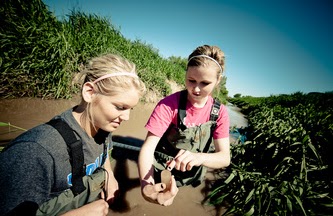
Twenty-three years later, the kids are still down in the creek every summer. How has a science project been sustained for so long?
“In my opinion, it’s the teacher,” said Ryan Chapman, assistant manager for the Lower Platte North Natural Resources District (LPNNRD).
Enter Mark Seier, who started teaching science at Newman Grove High School in 1975, two-and-a-half decades before he and an adventurous group of curious students would embark on an impactful journey that’s become part of the fabric of this school and this community.
“There was a time, early on, where I kept track of hours and the kids received a part of a credit for their participation, because we needed some incentive in those first few years,” Seier recalled. “Today, there is no incentive. They show up every summer and do it because they want to do it. That’s pretty special.”
It’s unique, too. The kids love the creek. They take ownership of it, and they celebrate milestones that point to the effectiveness of their work, which consists of wading through the creek testing water and soil. The data they gather is then presented to the NRD, SCWIG and community stakeholders each year. It’s imperative information for the NRD, and it’s dependable.
“They’re doing it every year, versus if the state were to do it, it would only happen every six years,” said Chapman. “They’re getting a better snapshot and an understanding of the trends that are happening from a year-to-year basis. The students are collecting a lot of data that allows us to really see what’s going on in the stream.”
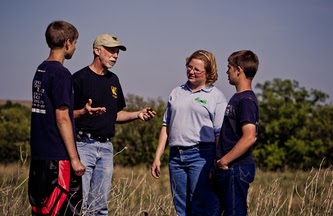
Seier, who is retired but still around and involved as a substitute, feels the partnership between the school district and the NRD is a key factor in the project standing the test of time. The NRD provides the funding for their studies, while the school essentially provides a bunch of invested interns.
“The NRD wins because they get the data, and the students win because they get a really neat educational opportunity that has led to connections and even careers down the road,” Seier said. “They get to work with the NRD staff members, which is a great experience. It’s just a win-win situation, as far as I’m concerned. Everybody comes out ahead.”
Seier and fellow teacher Gene Wissenburg first introduced a group of students to the conservation of Shell Creek through a collection of macroinvertebrates in 2002. Now, the science department’s yearlong curriculum prepares the students for their summer studies in the creek. Gradually, he’s handing the project off to the husband-and-wife science-teaching tandem of Brett and Andrea Miller, whose passion for the watershed rivals his own.
“I’m talking about the history, and they’re talking about the future,” Seier said with a smile. “It’s all part of the story. I hope they can take it in directions I didn’t even think of. I’m excited to see what that might be.”
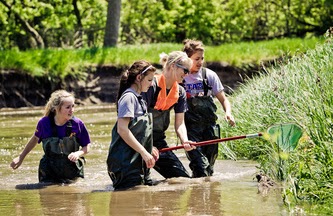
Andrea Miller is currently in UNL’s NSF Noyce Masters Teaching Fellows Program, and is using the Shell Creek Watershed as her portfolio project. She’s set on encouraging other districts to implement something similar in their schools, and looks to the future with excitement.
“In our family we have teachers in Wyoming who have said to me, ‘Are you paying these kids?’, or ‘How do you get these kids to come and do this on their summer break?’” Miller said. “We just provide the opportunity, and they seize it. We like to say we’re just the chauffeurs, and the students do everything else. Mr. Seier has really taught the older students to show the younger students the ins-and-outs of the process and how it works. It’s really a cool thing.”
The community is invested, too. In those early years, one of Seier’s students calculated the amount of erosion that was occurring in the creek.
“He discovered that after one of those hundred-year floods, there was enough dry soil in the water going underneath the bridge to fill our gymnasium with soil in an hour and 20 minutes,” Seier said. “And once the farmers started going to presentations and hearing things like that, they said, ‘Hey, I pay good money for that dirt. We can’t let that go.’”
In small towns, when students talk, people tend to listen.



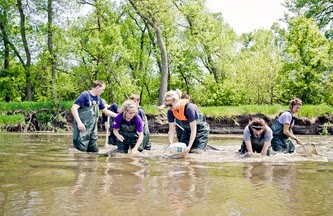
“Parents, grandparents, the community, they seem to listen to the kids more than they would if it was us calling or running something in the newspaper,” said Chapman. “The message, for whatever reason, seems to resonate more effectively with folks if it’s coming from the students. The kids know quite a bit, they know what’s going on. It’s more meaningful coming from them.”
The students, with the help of funding from the Nebraska Department of Environment and Energy 319 Program, the Nebraska Environmental Trust, the Nebraska Department of Agriculture Buffer Strip Program, Colfax County, USDA-NRCS EQIP Program and, of course, the NRD, have made sure they haven’t. When SCWIG approached Seier at the turn of the century, they were in the process of securing federal grants. To do so, they needed data.
“I said, ‘Well, okay, the kids can do that,’” Seier told them.
And have they ever. A study conducted by UNL five years ago found flooding to be less severe than when the practices were implemented two decades ago. Additionally, the creek was removed from the EPA’s Impaired Waters List in 2016 when Atrazine levels, which were sky-high a decade before, tested at normal levels, prompting a visit from then-Governor Pete Ricketts. Those tangible triumphs fuel the students at Newman Grove, a personable bunch who learn to love the Shell Creek from their older brothers and sisters and can’t wait for their first summer in wading gear.

“My sister always bragged about it and talked about how much fun it was,” said freshman class president Brylee Patzel, who one day hopes to become an ag advisor. “It was one of her favorite things, so I was excited for it. If there are kids who aren’t involved in many things around school, they always have Shell Creek. It’s just a great opportunity to meet people and to help out the community.”
We’ve gotten this far into the story without honing in on the students who are actually writing it. They’re the project’s heartbeat, multiple generations of teenaged water conservationists. They’ve gone on to do amazing things. Future fish technicians, wildlife biologists, science teachers, they’ve all waded the waters on Shell Creek.
“My dad always told me about Shell Creek, and about how his family’s always been a part of it,” said sophomore Jayden Benson. “It really interested me, and then I would hear about how much fun students would have and how much they’d learn. It’s a really great opportunity.”
Oliver Kaufman is vice president of the freshman class at NGHS, and though there’s a lot of time to ponder future careers, he has his eye on water management. His first couple of years studying Shell Creek may have had something to do with that.

“We hear about it growing up, and see the high school students down there during the summers, and it just kind of fascinates us,” Kaufman said.
Senior Aleeya Morris lives in town, not too far from Shell Creek. She spent plenty of time exploring the creek growing up and was eager to volunteer when the time came.
“It’s something that everybody loves,” Morris said. "Everybody in Newman Grove loves Shell Creek."
Student volunteers (everybody volunteers) spend two days each in May, June, July and August in the field. There’s never a dull moment. Interesting finds, from antique shoes to hundreds-of-years-old buffalo horns line the shelves in Brett Miller’s classroom, along with other posters, articles and various nods to the project’s notoriety.
“There are a lot of kids who actually learn better hands-on than through reading a book,” Jarecki said. “By going out and experimenting and doing things themselves with their hands, they’re learning better and they’re going to remember the experience better.”
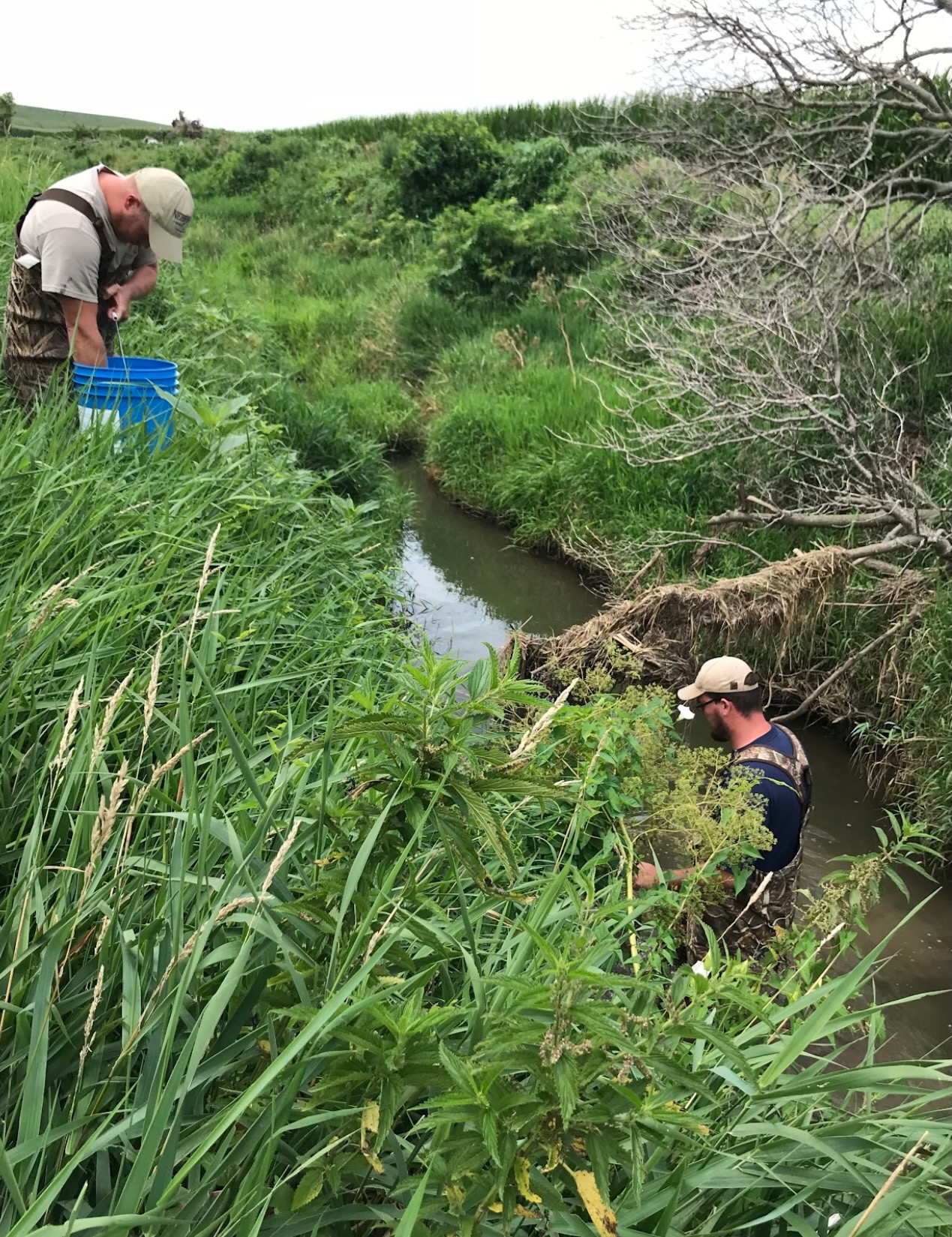
Educators are constantly striving to provide opportunities their students will remember.
“As a teacher, that’s what it’s all about,” said Brett Miller. “More hands-on opportunities. That’s all this is.”
Seier has always viewed education as a two-tiered entity.
“There’s two parts to education,” he said. “One is chopping the wood. That’s the curriculum-testing, the lesson plans, all those types of things. But the real magic in teaching is lighting the fire after you’ve chopped the wood. That’s what we’re doing when we set them loose in the summer.”
Jarecki and Morris were part of a student cohort that presented at the National Soil and Water Conservation Society’s International Symposium in downtown Des Moines in August of 2023. Chapman was there, and got a kick out of watching the crowd react to Newman Grove’s teenaged citizen scientists.
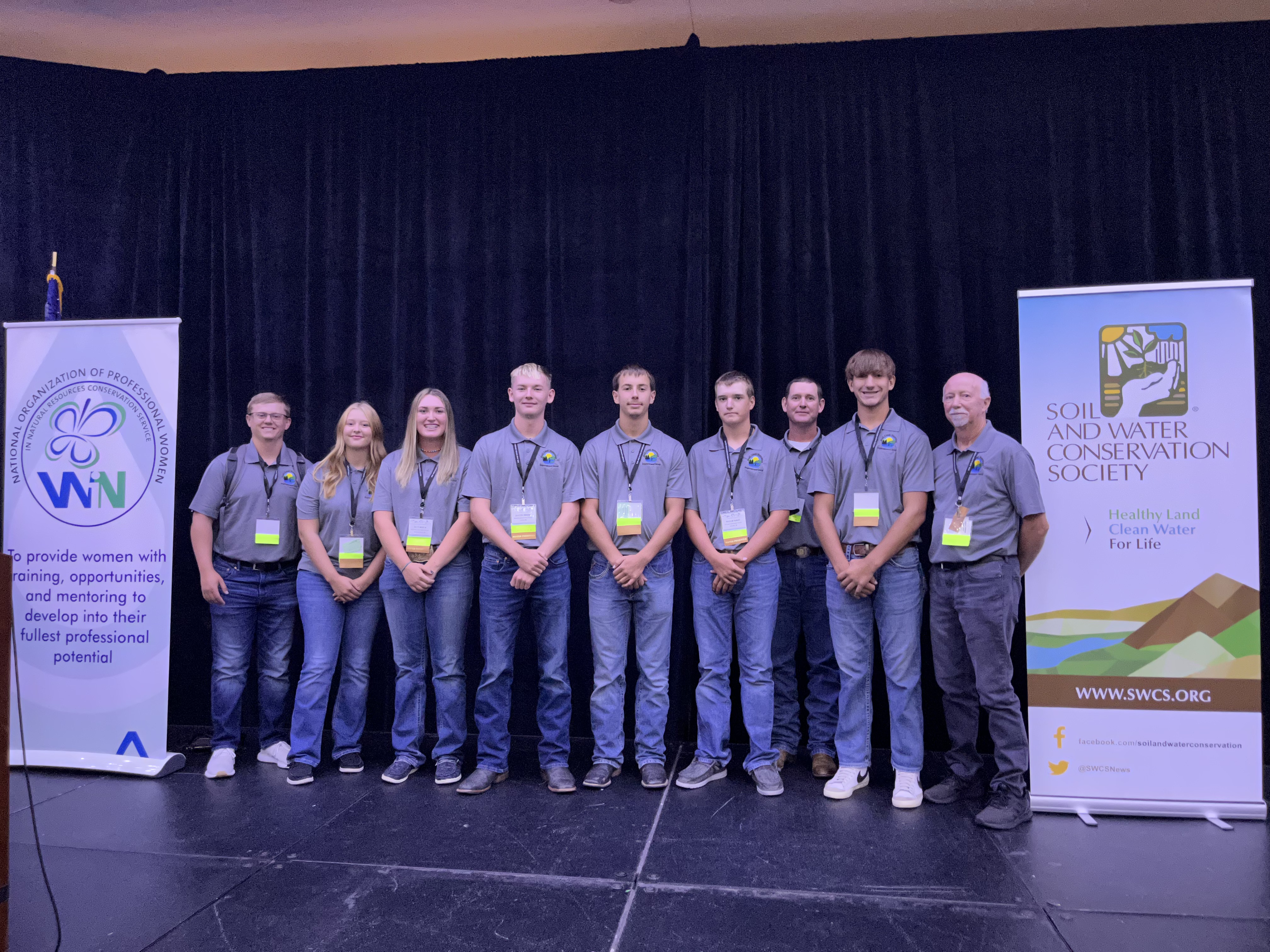
“People in the audience, professors with PhDs and upper-level management people from federal agencies, were just kind of in awe of what these students were doing,” Chapman said. “What a great experience that was for those students, both academically and professionally. A lot of them probably aren’t going to go into environmental sampling, but a lot of them are going to pursue something in the scientific realm, so what they’re learning is valuable.”
In the last couple of years, two more school districts, Schuyler and Lakeview, have become involved. Their students participate in the yearly data presentation to the NRD Board.
“We have the Shell Creek covered from its headwaters to the confluence with the Platte River,” said Seier. “That’s a neat thing, to have an entire watershed that’s being monitored by students for the NRD.”
Around here, the future is just as exciting as the past. One generation simply hands the pen to the next.
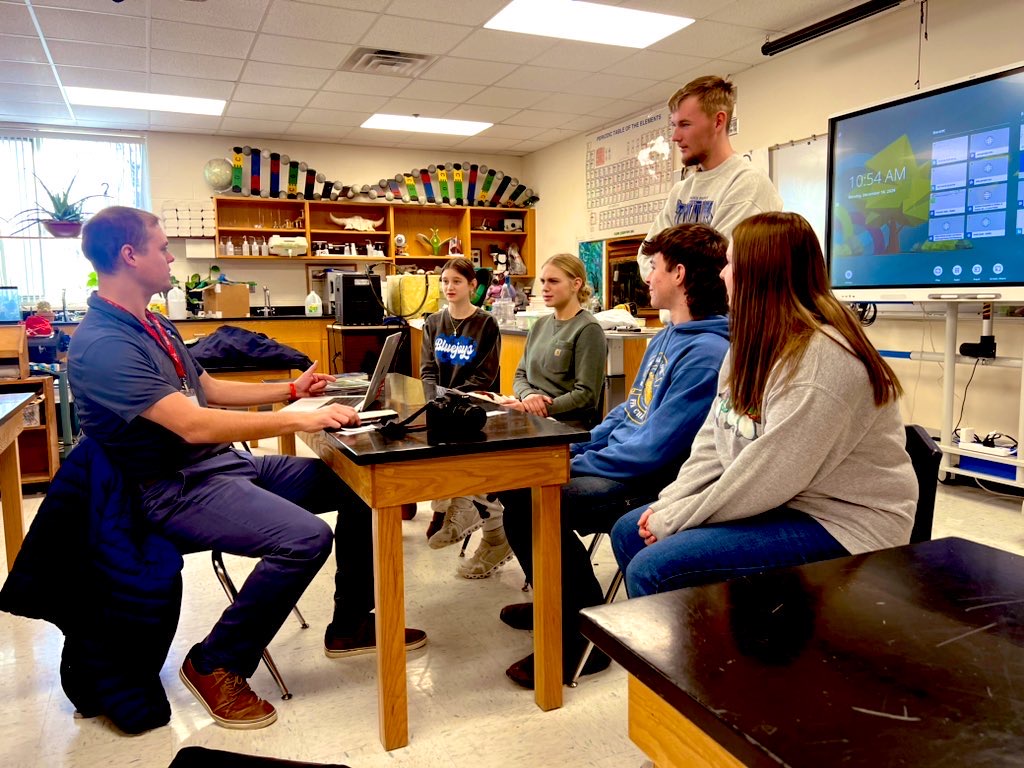
“We’re connecting cross-curricularly now, which kind of brings it all full-circle,” said Andrea Miller. “I have one student working on DNA and trying to determine which bacteria is actually present in Shell Creek, and I have another basing her project off scientific research that is going on at UNL, where they’re trying to use remediate or bioprocesses to lessen the nitrates in the creek.”
How cool is that?
“Right now, the main thing we’re testing for is nitrates,” said Benson. “Shell Creek has always been kind of high in nitrates, so we’re looking at possible ways to bring that down.”
This is Newman Grove, where their citizen science project never sleeps.
And that is their creek, a stream of water that carries a story nearly a quarter century in the making.
“We want to keep this going,” said Patzel. “We want to make sure the Shell Creek stays here forever.”
